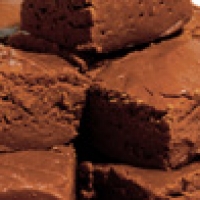Fudge
From tuilelaith 16 years agoIngredients
- 3 ounces unsweetened chocolate, coarsely chopped (3 1-ounce squares) shopping list
- 3 cups sugar shopping list
- 1 cup half-and-half shopping list
- 1 tablespoon corn syrup shopping list
- 1/4 teaspoon salt shopping list
- 3 tablespoons butter shopping list
- 2 teaspoons vanilla extract shopping list
- 1 cup nuts and/or dried fruit, chopped (optional) shopping list
- ~~~~~~~~~~~~~~~~~~~~~~~~~~~~~~~~~~~~~~~~~~~~~ shopping list
- an 8-inch-square pan shopping list
- waxed paper shopping list
- a large (3- to 4-quart) saucepan shopping list
- a wooden spoon shopping list
- a candy thermometer shopping list
- a pastry brush shopping list
- a marble slab (optional) shopping list
- a spatula (optional) shopping list
- a cutting board shopping list
How to make it
- Prepare your square pan by greasing it with butter or lining it with waxed paper.
- Mix together chocolate, sugar, half-and-half, corn syrup, and salt in the saucepan.
- Stir over medium-low heat with a wooden spoon until the chocolate melts and the mixture begins to boil.
- As soon as the syrup starts to boil, stop stirring and clip the candy thermometer to the side of the saucepan, being careful not to let it touch the bottom.
- Let the syrup cook, undisturbed, until it reaches the soft-ball stage, about 235° F–240° F.
- While it cooks, wash down the sides of the saucepan with a pastry brush dipped in a small amount of warm water to loosen and dissolve any sugar crystals clinging to the sides.
- Carefully remove the saucepan from the heat and let the mixture rest, undisturbed.
- Let it cool to approximately 110° F.
- At this point, a slight skin should have formed on the top.
- Be patient—this may take a while!
- (Alternatively, you may pour the mixture onto a marble slab at this point and allow it to cool on the slab—this is the way that professionals make fudge.)
- Add the vanilla and butter and begin to stir with a wooden spoon.
- (If you are adding nuts or dried fruit, add them just before the mixture completely loses its gloss.)
- You don’t need to use a lot of force, but you should keep stirring constantly until the fudge “sets up.”
- You will be able to see the mixture gradually change from glossy to dull, lighten in color, and stiffen.
- Again, patience (and a strong arm) is needed—this change can take from 15 to 20 minutes to occur!
- (Be careful not to beat too long or too hard—this can result in a coarse, grainy fudge, as can stirring while the fudge is still too hot.)
- ~ ~
- If you're adding nuts or fruit, you may want to warm them slightly in a microwave before adding them.
- If they are too cold, the temperature difference may “shock” the fudge and cause it to solidify too quickly.
- ~~~~~~~~~~~~~~~~~~~~~~~~~~~~~~~~~~~~~~~~~~~~~
- Soft-Ball Stage
- 235° F–240° F
- sugar concentration: 85%
- At this temperature, sugar syrup dropped into cold water will form a soft, flexible ball. If you remove the ball from water, it will flatten like a pancake after a few moments in your hand.
- ~~~~~~~~~~~~~~~~~~~~~~~~~~~~~~~~~~~~~~~~~~~~~
- Did You Know?
- Fudge was invented in the United States around 100 years ago.
- The exact origins are disputed, but all accounts claim that the first batch of fudge was accidentally created by failing to make another type of candy—possibly caramels.
- Many stories also claim that fudge was invented by students at a women’s college—Vassar, Smith, or Wellesley.
- ~~~~~~~~~~~~~~~~~~~~~~~~~~~~~~~~~~~~~~~~~~~~~
- Why do I add corn syrup?
- Corn syrup acts as an "interfering agent" in this and many other candy recipes.
- It contains long chains of glucose molecules that tend to keep the sucrose molecules in the candy syrup from crystallizing.
- In fudge, the addition of "interfering agents" can be a double-edged sword: you want crystals to form, but not until the cooked mixture has cooled down to a certain degree.
- ~~~~~~~~~~~~~~~~~~~~~~~~~~~~~~~~~~~~~~~~~~~~~
- Why do I add vanilla?
- Vanilla is often added to chocolate candies or other chocolate recipes because it complements and accents the flavor of chocolate.
- ~~~~~~~~~~~~~~~~~~~~~~~~~~~~~~~~~~~~~~~~~~~~~
- Why do I need to stop stirring after the syrup begins to boil?
- At this point, you have dissolved the crystal structure of the sugar.
- Stirring or other agitation is one of the many factors that can encourage the fructose and glucose molecules in your syrup to rejoin and form sucrose—crystals of table sugar.
- ~~~~~~~~~~~~~~~~~~~~~~~~~~~~~~~~~~~~~~~~~~~~~
- Why do I wash down the sides of the pan?
- The sugar crystals are dissolved at this point in the process.
- But a single seed crystal of sugar clinging to the side of the pan might fall in and encourage recrystallization.
- ~~~~~~~~~~~~~~~~~~~~~~~~~~~~~~~~~~~~~~~~~~~~~
- Why does the fudge need to cool for such a long time?
- The key to a smooth and creamy texture is a fudge that's full of thousands of tiny sugar crystals.
- Heating the syrup to a high temperature and then allowing it to cool, undisturbed, produces a supersaturated solution—this means that the solution contains more sugar molecules than would normally be possible at room temperature.
- A supersaturated solution is highly unstable, and any agitation will cause crystallization to occur throughout the solution.
- If fudge is stirred while it's still hot, fewer crystals form, and they grow larger as the syrup cools, resulting in a coarse, grainy candy.
- ~~~~~~~~~~~~~~~~~~~~~~~~~~~~~~~~~~~~~~~~~~~~~
- Why is it so important to keep stirring until the fudge "sets"?
- Stirring helps control the size of the sugar crystals that form—it keeps them from growing too large, which would produce gritty fudge.
The Rating
Reviewed by 9 people-
Sure does look easy and even looks good.
 sandygalesmith
in Saint Joseph loved it
sandygalesmith
in Saint Joseph loved it
-
Loving it!
 mrsc543
in North Reading loved it
mrsc543
in North Reading loved it
-
Good!!
 cuzpat
in Sikeston loved it
cuzpat
in Sikeston loved it
The Groups
- Not added to any groups yet!


Reviews & Comments 6
-
All Comments
-
Your Comments
" It was excellent "
" It was excellent "
" It was excellent "
" It was excellent "
" It was excellent "
" It was excellent "